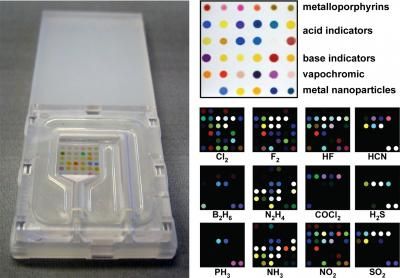Weizmann scientists developed an electronic 'nose' that can predict the pleasantness of novel odors
These findings have implications for automated environmental toxicity monitoring and transmitting scent digitally
Weizmann Institute scientists have 'trained' an electronic system to be able to predict the pleasantness of novel odors, just like a human would perceive them – turning the popular notion that smell is completely personal and culture-specific on its head. In research published in PLoS Computational biology, the scientists argue that the perception of an odor's pleasantness is innately hard-wired to its molecular structure, and it is only within specific contexts that personal or cultural differences are made apparent.
These findings have important implications for automated environmental toxicity and malodor monitoring, fast odor screening in the perfume industry, and provide a critical building block for the Holy Grail of sense technology – transmitting scent digitally.
Over the last decade, electronic devices, commonly known as electronic noses or 'eNoses,' have been developed to be able to detect and recognize odors. The main component of an eNose is an array of chemical sensors. As an odor passes through the eNose, its molecular features stimulate the sensors in such a way as to produce a unique electrical pattern – an 'odor fingerprint' – that characterizes that specific odor. Like a sniffer dog, an eNose first needs to be trained with odor samples so as to build a database of reference. Then the instrument can recognize new samples of those odors by comparing the odor's fingerprint to those contained in its database.
But unlike humans, if eNoses are presented with a novel odor whose fingerprint has not already been recorded in their database, they are unable to classify or recognize it.
So a team of Weizmann scientists, led by Dr. Rafi Haddad, then a graduate student of Prof. Noam Sobel of the Neurobiology Department and co-supervisor Prof. David Harel of the Computer Science and Applied Mathematics Department, together with their colleague Abebe Medhanie of the Neurobiology Department, and Dr. Yehudah Roth of the Edith Wolfson Medical Center, Holon, decided to approach this issue from a different perspective. Rather than train an eNose to recognize a particular odor, they trained it to estimate the odor along a particular perceptual axis. The axis they chose was odorant pleasantness. In other words, they trained their eNose to predict whether an odor would be perceived as pleasant or unpleasant, or anywhere in between.
To achieve this, the scientists first asked a group of native Israelis to rate the pleasantness of a selection of odors according to a 30-point scale ranging from 'very pleasant' to 'very unpleasant.' From this dataset, they developed an 'odor pleasantness' algorithm, which they then programmed into the eNose. The scientists then got the eNose to predict the pleasantness of a completely new set of odors not contained in their database against the ratings provided by a completely different group of native Israelis. The scientists found that the eNose was able to generalize and rate the pleasantness of novel odors it never smelled before, and these ratings were about 80% similar to those of naive human raters who had not participated in the eNose training phase. Moreover, if the odors were simply categorized as either 'pleasant' or 'unpleasant,' as opposed to being rated on a scale, it achieved an accuracy of 99%.
But these findings still don't determine whether olfactory perception is culture-specific or not. With this in mind, the scientists decided to test eNose predictions against a group of recent immigrants to Israel from Ethiopia. The results showed that the eNose's ability to predict the pleasantness of novel odors against the native Ethipoians' ratings was just as good, even though it was 'tuned' to the pleasantness of odors as perceived by native Israelis. In other words, even though different odors have different meanings across cultures, the eNose performed equally well across these populations. This suggests a fundamental cross-cultural similarity in odorant pleasantness.
Sobel: 'Being able to predict whether a person who we never tested before would like a specific odorant, no matter their cultural background, provides evidence that odor pleasantness is a fundamental biological property, and that certain aspects of molecular structure are what determine whether an odor is pleasant or not.' So how are cultural differences accounted for? 'We believe that culture influences the perception of olfactory pleasantness mostly in particular contexts. To stress this point, many may wonder how the French can like the smell of their cheese, when most find the smell quite repulsive. We believe that it is not that the French think the smell is pleasant per se, they merely think it is a sign of good cheese. However, if the smell was presented out of context in a jar, then the French would probably rate the odor just as unpleasant as anyone else would.'
The scientists' findings that odor perception is hard-wired to molecular structure and their design of an eNose that is able to classify new odors could provide new methods for odor screening and environmental monitoring, and may, in the future, allow for the digital transmission of smell to scent-enable movies, games and music to provide a more immersive and captivating experience.



























































